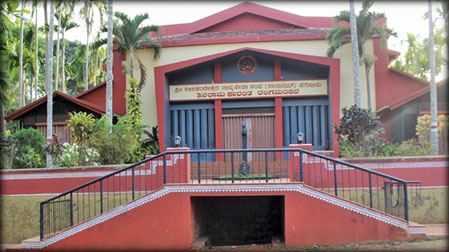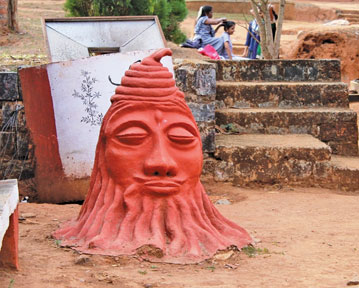|
The Ninasam Diary:
The Mecca of Indian theatre
By Dr. Ajay Joshi
[Part 1]
 |
|
The Ninasam theatre |
Tucked away in the Mallad region of the State of Karnataka is the
small village of Heggodu. Surrounded with arecnut trees and a rich
landscape, it is dotted with tiny houses and mud roads. And amidst this
nestles Ninasam (Neelkantheshwar Natya Sangha), a cultural movement,
which has affected the lives of the many fortunate in the surrounding
communities.
It was here that, during the years of the partition of India, way
back in 1947, a group of visionaries, felt the need to engage the youth,
who otherwise whiled away their time. And they decided to use the arts
to rope in their interests. Literature, poetry, theatre, community
activities and films introduced over the years, and what started as an
experiment has grown into a full- fledged theatre activity in these
remote parts.
Such was the impact created that it affected nearly 200 villages and
its inhabitants in its immediate surroundings, inculcating in them a
penchant for the arts, that its founder K.V. Subanna got the Magsaysay
award for this activity , considered on par with the Nobel prize.
Today any ordinary person would speak at length of Akira Kurosawas’s
films, claim to have watched many versions of King Lear, critically
opine on film-maker Satyajit Ray’s lighting design for his films or
casually engage in an animated discussion on theatre.
Mecca
Considered as the Mecca of Indian theatre, it is in its numerous
spaces that the theatre community longs to perform at least once. And
the who’s who of the theatre and artistic world have all been here.
In the initial years the people would meet in the evenings to gossip,
to discuss contemporary issues and events, and to occasionally put up a
theatric production.
These random activities crystallised into strong interests, leading
to the formation of an amateur cultural troupe that the founders named
Nilkantheswara Natyaseva Sangha (Ninasam) after a local deity. Over the
years it was blessed by eminent personalities in the field of theatre,
literature, arts, culture and education. It expanded its scope to
encompass the community, while it itself grew in infrastructure and its
theatric reach.
Having traversed a tumultuous journey, today it houses the Ninasam
Theatre teaching institute (where the audience have been witness to
productions from Samsa to Shakespeare, Tagore to Chekhov, from Kalidasa
to Bretch). Established in 1980, it offers the 15 to 20 selected
students, a 10-month course in theatre arts, styled in the NSD (National
School of Drama) model. The emphasis is working in non-urban conditions,
where the students are given a teaching scholarship covering food and
stay expenses, with an intensive residential training. The next
highlight is the Ninasam Tirugata (A Mobile theatre run by the past
students of the institute,
having reached an audience of more than 20 lakh people in the
mofussal parts of the state). Established in 1985, a group of 20
artistes, shortlisted from the graduating batch, handle both the onstage
and offstage work and are paid equally. In their repertoire are three to
four plays rehearsed from July to September and then the tour shows of
the same are held from October to March each year.
 |
|
An art work |
They play one show every 50 to 100 kms of travel with a performance
practically each day, totalling about 120 shows in 140 days, which is in
itself a teaching experience not only as performing artistes but in
community living.
Apart from these there is there is the Ninasam Film Society, Ninasam
Janaspandana (which took the best of world cinema and theatre to the
doorsteps of the mofussil and rural communities of many parts of
Karnataka), Ninasam Prathisthana (a foundation set up with the purse
Subanna received as part of the Magsaysay award, which holds short-term
courses in literature, drama and theatre, and allied arts for college
students and members of cultural groups).
Along with this it also has been instrumental in running projects
like the annual theatre festival in May, Summer theatre workshops,
Children’s workshop and the Culture course in October. Ninasam also has
a publishing house, Akshara Prakashan, which has been instrumental in
publishing some of the best in regional and world literature into
Kannada, for the benefit of the locals. Partly dependent on the State
Government for funding for stipends for its students and payments to the
repertory actors, it relies on donations and goodwill for sustenance.
Proscenium theatre
Ninasam has its own proscenium theatre built of local material and
also houses other alternate performing spaces, which have been
tastefully created, again using indigenous material. Apart from this
there are housing facilities for the students and guests, a well
equipped library, an office space and a mess, all designed simply but
artistically.
Wood carvings, sculptors and wall paintings are all over. It
encourages network and makes available the few rooms that comprise their
guest quarters, if one were to do research, use their exhaustive library
or then write a book. It was amazing to see the commitment with which
the people go about the work assigned to them, which spells volumes of
the strong bond that has been built over the years.
During any of the programs when the place is milling with guests, the
local villagers voluntarily come forth to help in the dining hall,
serving the guests, as if it their own family function.
Among the numerous activities it conducts throughout the year, one
such popular, is the culture course. Cultural activists, students,
teachers, academicians, professionals, theatre practitioners assemble
here and are put through a routine which involves academic discussions
on a pre-announced theme by experts in the field, debates, platform
performances, evening performances followed by post-production
discussions etc, that makes this activity popular and testimony of its
success over the past 23 years.
Production
I was invited this year to be a part of the post production
discussions. In this series I will focus on the four productions that I
witnessed. Two of these were performed by the Tirugata, the mobile
theatre wing of Ninasam, one by the enthusiastic artistes of the
community and the fourth an invited play from Mumbai-‘Sita
Swayamwara’,’Gandhi Viruddha Gandhi’, ‘Jugari Pass’, ‘Stories in a
Song’. Each of these was distinct from the other in form, content,
direction, acting styles and the general layout of the final
presentation.
And without a doubt, I came away largely impressed with the attempt
on stage and the over-packed auditorium.
The writer is a practising Dentist, with a PhD on Theatre Criticism,
and Master’s in Journalism and Mass Communication. He has freelanced
with major Indian and International newspaper, magazines and journals on
theatre and culture. He has been involved in theatre festivals as media
person, organiser, coordinator and judge. A translator of many Marathi
plays into English, he has numerous papers on theatre in national and
international seminars, to his credit. A visiting lecturer on theatre
and journalism at Symbiosis University, University of Pune and Flame
School of Performing Arts, he currently writes on theatre for Saakal
times, E-Rang and Critical Stages.com, a journal of the International
Association of Theatre Critics. |

